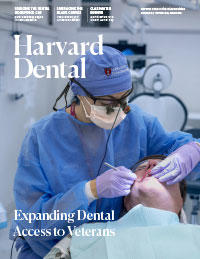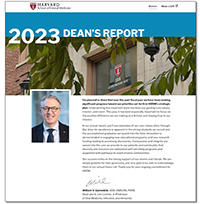
When Dr. Bjorn R. Olsen, professor of Developmental Biology at Harvard School of Dental Medicine (HSDM), and Hersey Professor of Cell Biology at Harvard Medical School (HMS) received funding for his NIH R01 grant, “Biogenesis of Extracellular Matrix” in 1985, his expectations were high that it might yield a new discoveries related to collagen-like proteins. Much to his delight, the grant, now extended for years 33 and 34, has been one of the most prolific in the history of the School, leading to a remarkable number of discoveries and touching the careers of nearly 100 faculty and postdocs who have collaborated with the Olsen Lab over the years—many of whom have gone on to become leaders in academia and medical research themselves.
"The early expectation for the grant was that it would lead to insights into the structure and function of several collagen-like proteins in the extracellular matrix of connective tissues, cartilage and bone, but how quickly these discoveries resulted in projects identifying mutations in several genetic skeletal disorders was unexpected, exciting and satisfying," said Olsen.
“Biogenesis of Extracellular Matrix” has led to more than 153 published papers and six patents from 1987 to 2017. The grant stands out as one of the longest-running grants at both Harvard medical and dental schools, with only one grant achieving more longevity (topping 44 years).
By simultaneously addressing questions related to genetic skeletal disorders and vascular disease, Olsen has been able to characterize complex developmental and disease mechanisms at the intersection between skeletal and vascular biology. This has led to the discovery of novel gene families that are critical in bone formation, and furthered the understanding of limb malformation syndromes and disorders characterized by lack of bone formation.
Olsen’s work has also uncovered mechanisms in many collagen-based genetic diseases such as dwarfism and early-onset osteoarthritis. Discovery of the gene for Osteoporosis pseudoglioma syndrome established the basis for understanding the critical role of Wnt signaling in bone formation. Studies of the craniofacial bone disorder Cherubism led to mapping the gene for excessive bone formation in Craniometaphyseal dysplasia, leading new insights into its role in regulation of bone mass.

More recently, his work has led to new insights into the role of vascular endothelial growth factor in differentiation of stem cells to osteoblasts, and mechanisms responsible for human GAPO syndrome, characterized by severe premature aging, pseudoanodontia, and other craniofacial, skeletal and connective tissue anomalies.
“Dr. Olsen’s groundbreaking discoveries have allowed scientists to view the extracellular matrix as a vital part of the biological information required for normal embryonic development.” Dr. Vicki Rosen, professor of Developmental Biology and chair of the Department said. “This has provided fundamental insights into how changing this information results in disease.”


